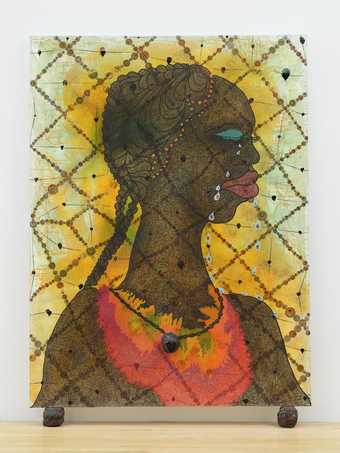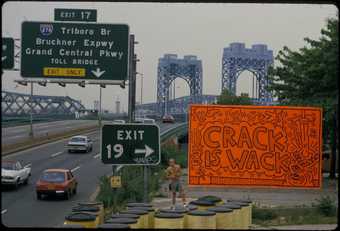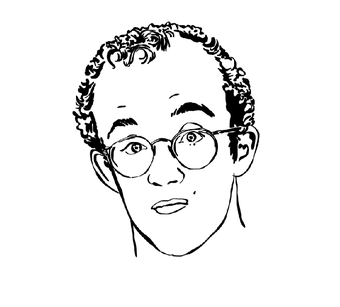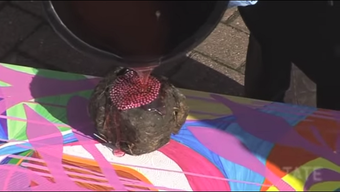
Chris Ofili
No Woman, No Cry
(1998)
Tate
I say hip hop is black expression.
Everything is art.
Hip hop is more than music.
Creativity explodes and becomes fully energetic as soon as arts combine and arts begin to talk to each other.
[music]
Bridget: I'm Bridget Minamore. I'm a writer and a poet and I write poems about love, home, diaspora and music. This episode we'll be looking at how the culture of hip hop has collided with art in many forms. Hip hop has always been poetry to me. It's helped me see things better, not differently, but clearer. Lyrics have always made my brain connect to a new frequency almost, while a great beat can hit something in my chest like nothing else.
When we talk about hip hop, we need to talk about a strong connection with black culture. It all started as an artistic and social-political movement that stems from the Bronx in New York in the early 70's. Zezi Ifore, broadcaster and creative consultant, talks about how black people's lived experiences birthed hip hop.
Zezi: It just came up of inner-city life. Lots of struggle but also lots of joy. I think, actually, a lot of this stuff sometimes we can talk about it-- In terms when we talk about black art forms and black work, it's always seems to be tethered to this idea of like making something good out of something bad, but I think it's bigger than that. I think it's about expression. It's about being a human being, being alive, expressing yourself and releasing.
I think black people have been excellent at that since the dawn of time. Before slavery, we had many forms of art and storytelling and expression that weren't just about, "Oh, let me just transcend the horror of my day to day life." It's like, this is just how we are. We can kind of look at the fact that yes, inner-city life in downtown New York for black people in the early 70's was probably not a vibe, but I feel like they would be making this stuff even if it was because that's just what it is to be black.
Bridget: Hip hop, the raps, the instrumentals, and the scratches have reached spaces beyond the Bronx. It has connections with global politics and social movements and the art worlds. Fine art and hip hop might seem separate and distant, but the two worlds are constantly merging. Major hip hop artists have become vocal art collectors and fans.
Jay-Z’s appreciation for Jean-Michel Basquiat is a great example of this. He has been name-dropping the artist in his raps for years and even brags about his daughter Blue Ivy owning a Basquiat painting. Speaking of Basquiat, he and Artist Keith Haring were both key figures in showing hip hop aesthetics in their work. From Basquiat's entitled History of the Black people, which linked the history of the Egyptians to Africa to Haring's mural Crack Is Wack which was displayed in the streets of Harlem. Both these artists portrayed the social issues faced by Black and LatinX communities in their art.
Darren Pih is an expert on Keith Haring. He's a curator at Tale Liverpool and he's co-curator of the first UK solo exhibition of the American artist and activist. He talks about Haring's work and how he merged the worlds of hip hop and art.
Darren Pih: Haring is somebody who was born in Pennsylvania. He moved to New York City in 1978. I think at the time-- Now, looking back at Keith Haring's work he was a painter. He made drawings and public murals. He made works on the New York subway in their thousands. His work somehow seems synonymous with the cultural energy of New York City in 1980s. He's somebody who, he becomes a student, but very quickly, clubbing and club culture becomes a really big part of his life.
Actually, you can see this in the visual iconography of his work. His paintings seem to recall hip hop. He was really somebody who was also looking at graffiti artists. He becomes very close with Jean-Michel Basquiat and street artists who were making works on the street, on trains, who were breaking into train yards and he sort of saw this, this street art, it's very immediate, vivid form of expression.
He linked it to abstract painting. He sort of talked about this direct flow hand to eye flow of this spray can and having that sort of no hesitation, really confident but like abstract painting, like Jackson Pollock is somebody who's very interested in producing art that's seen by as many people as possible.
Bridget: Haring's ability to go outside the gallery space, outside of museums shows that art can and should live outside these spaces. Zezi talks about the art world she is exposed to.
Zezi: I don't think there's one art world. I think there's many art worlds, it just depends which one you are in. My art world is the world in which P. Diddy is buying Kerry James Marshall's painting, buying it for $21 million, a record-breaking price at auction, not just for the artist himself but also is the highest price ever paid for a work by a living African American artist and it's like in 2019 anyone who is othering black art or hip hop in the art world is just not living in the real world.
Bridget: Having a different experience of art is something visual artist King Saladeen talks about. He touches on his experiences of getting introduced to a new art world when the only art he saw before this was in hip hop or on the street.
King Saladeen: I actually got introduced to Basquiat probably like maybe eight, nine years ago. Just because when I started putting artwork up on my Facebook, people said, "You're almost just like Basquiat," and I'm like, "Who are they talking about? Is this some dude from like Philly?" or I had no clue. You know what I'm saying? This is how like mind clouded I was from actual knowing about art.
I couldn't go the direct gallery route or like if I was a student of a pristine art school and somebody recommended me to this gallery and, or this museum, you know that's how it usually goes from my perspective where I see a lot of people in the art world, they're locked into their secret society and that's how different opportunities come about. I knew that wasn't going to be for me because I didn't go to school.
If you're coming into the art world, I didn’t look at street art or graffiti as something that I could sell. I just had the vision and I've seen it and over time you just get better with different things. That you can be successful in art outside of the galleries, outside of being in museums and just being outside of being dead.
Bridget: Being a successful artist out of what is deemed as high art is something Keith Haring and other artists considered. Living culture became an inspiration for art. Darren talks about this.
Darren: There were many artists. It was probably lots to do with the economy in the 1970s, the economy in America were very poor. It was a time of recession. By 1980, it was probably a time where there were very few opportunities to exhibit work in conventional ways. The street itself becomes activated, nightclubs become activated as spaces where you can show films or show performances or show paintings. I mean, I guess in retrospect it's how inner-city areas are regenerated by living culture, by artists and musicians and writers and poets because there's a natural instinct to produce. It's like the street itself becomes a campus.
Bridget: Zezi adds to this.
Zezi: Hip hop to me is the perfect example of a Gesamtkunstwerk. I'm not German, forgive the pronunciation. Basically, refers to a work of art that makes use of lots of art forms. It means literally total artwork, a complete artwork and often some people talk about Opera in that way because there's so many elements to Opera from the singing, the musicality, to the expression, the acting, the set designers, so many things going on.
I would say hip hop is a Gesamtkunstwerk because it is a world, it came out of club culture and nightlife and brought parties in New York. There's this live happening physical element. There is what you're wearing to the club. There's the artwork for the club. There's the flyers, like Keith Haring doing flyers for parties. There's the music itself, that innovation. There is the artwork for the albums that come out of it. It is a whole world.
Bridget: Zezi mentions the role block parties played in hip hop and this is something Pierre Huyghe focused on in his art film titled Block Party. Block parties are a part of the history of hip hop. It is a party for all the residents of a block or neighborhood. He took his creation of art into the Bronx and filmed one of these parties. Andrea Lissoni, senior curator at Tate Modern speaks about block party and the impact it had in the art world.
Andrea Lissoni: Block party, Pierre Huyghe's film that one encounters in a gallery normally. It's not screened in the cinema and shows a party taking shape in an informal environment. It could be any town, looks like New York and it is actually New York. What you see is that people gathering around a sound system and a sort of celebration taking shape. There's a music actually, on one channel and in the other one there's a story that it's going to be told and unfolds.
The story that is told is a story of how hip hop became such a relevant form of expression and form of art, through the domain figures that were involved in making hip hop a crucial moment in contemporary culture. The world has an interesting autonomy. It's both a strange document, an interesting document of a moment in time. A very short document and very pertinent work in Pierre Huyghe’s career.
Pierre Huyghe has been always interested in collaboration, in life that unfolds in a sort of non-controlled way and just between control and non-control, and in relationships. Hip hop is very much about collaboration. Is very much about change. It's very much about something that takes shape in an urban space and then disappears. It's very much about the language.
Bridget: This climate of DIY creativity mixing and recreating is tightly linked with hip hop and also art. In an interview with Donna DeSalvo, artist Chris Ofili references this. He says, "I like hip hop's cut and paste attitude. You can often hear where one joint ends and another begins, which is something I try to make apparent in my work so you can see how things are made. Hip Hop takes existing beats, restructures them and injects the individual in the form of a rap." Andrea talks about how this technique is reflective of collage.
Andrea: Cut and paste first, and cut and mix after, emerge in, I want to say, the late 50s but was already there in the early movement of the avant-garde as collage. Of course, collage is bi-dimensional. It's based on the idea of painting. It's a form of bringing elements of everyday life into the authoritative space of painting. Bringing something that belongs to off the frame within the frame, that was the gesture that motivated part of art related to collage or art made out of collage.
Bridget: Here's Zezi Ifore again.
Zezi: Hip Hop was born out of innovation. Musically speaking, we're talking about pioneering new sounds using new technology like electronic synths and all these 808 drum machines that just did not exist before and finding new ways to use this new technology. It birthed this artform of djing, of putting one record on top of another and blending them seamlessly. It birthed sampling, taking a bit of an existing song, isolating it, adding it to something else and chopping it up. It birthed remixing. All of this comes from hip hop culture.
Bridget: Art films to small screens, film, video, and imagery are key components in hip hop. The music videos allow the lyrics to come to life and the cover images are the new elements of the story. Visual artist King Saladeen talks about how rapper Kanye West album cover for The College Dropout, which showed a bear college mascot inspired his collection Bear Season.
King Saladeen: Definitely, it was inspired by College Dropout. The story behind that was about maybe 10 years ago. I come home from working. I worked with kids at a placement, a judicial system pretty much where kids get locked up with foster homes and things like that. I started with like a little art group for the kids that was like fighting the most of the day and things like that just to get them off of the unit and do something constructive.
While I'm at work, I'm drawing a painting, I'm doing all my things too. That was just one boring day. I have the album cover in my bag. I'm just like, "Y'all can make this bear way cooler. I can make this dude from Philly." You know what I'm saying? "It's cool, but I can make it cooler."
Bridget: Zezi talks about her favorite album cover.
Zezi: I mean, hip hop-- Again, one of the reasons why its influence is just so enduring is that it has gone hand in hand with iconic imagery, iconic styles of dressing iconic videos, iconic artworks. These are things that have been seared into our minds once we see them. The first one I did think of was that Notorious B.I.G, Ready to Die. It's a classic one. It's almost like, that's almost going to be a cliché answer at this point.
I remember being struck by the fact that there's this beautiful little black baby on the cover. Innocent, pure, beautiful, and the simplicity of the album as well. Graphically and visually, it's very striking because it's quite simple and stuck. It's classic, but then the title is ready to die. It's like that kind of juxtaposition, that contrast of new life and death and being prepared for imminent death may be and just what that reality is.
Bridget: Rapper Little Simz.
Little Simz: My first two albums the cover was done by artists. I think my second album I dived a bit more into that world. I worked with an artist called McKay Felt. How I met him was on my first album. Basically, we had like 10 students from an Art University submit artwork for each one of my songs. McKay submitted a piece and I really, really connected with his over everyone else.
I decided to work with him for my second album and we made a comic book and then I put on a festival and had him do an exhibition with another artist called Corey Wash, she's from the States. I've always been super passionate about art and I've always respected artists so much to where I wanted to include it into what I'm doing heavily.
Bridget: When speaking about the art of hip hop, what we can clearly point to moments where creativity explodes because of the meeting of the two art forms.
Zezi: Art of hip hop is that hip hop is art. That's the art of hip hop. It is art, full stop, and it is wonderful. It's rich. There's so much breadth to the art of hip hop. Is a totaller. It's a perfecter.
Bridget: To see the amazing work of Keith Haring at Tate Liverpool, use the code 241HARING to get two for the price of one ticket. The offer is available online only between the 1st and 31st of October 2019. The Art of Hip Hop is a tape podcast produced by Tolani Shoneye. It was a Boomshakalaka production with music by Buddy Peace. If you've enjoyed this podcast, please rate, review and subscribe.
End of transcript
This episode is a brief introduction to how the culture of hip hop has collided with art forms such as painting, installation art, photography and film. We follow its beginnings as an artistic and socio-political movement in the Bronx in the early 70s to its many manifestations throughout culture today.
Hip hop’s rich history goes beyond its engagement with visual arts. The genre holds an important space within discussions around race and social change, too complex to do justice to here.

Tseng Kwong Chi
Crack is Wack Mural, 128th Street and Second Avenue, New York 1986
© Muna Tseng Dance Projects, Inc., New York
Keith Haring artwork © Keith Haring Foundation
Discover the late Keith Haring’s take on graffiti through his subway drawings and billboards such as Crack is Wack, as well as contemporary artists such as Chris Ofili, who references hip hop’s cut and paste approach.
Join us as we take a whistle stop tour with curators, musicians and visual artists about the influence of this art form and how hip hop’s ability to bring together multiple mediums in one space has revolutionized the creative industry.
The Art of HipHop is a Boomshakalaka production, produced by Tolani Shoneye.
Want to listen to more of our podcasts? Subscribe on Acast, Apple Podcasts, Google Podcasts or Spotify.



